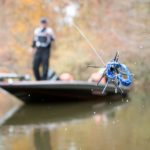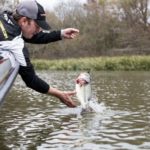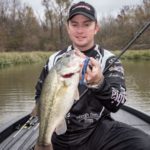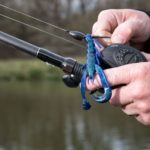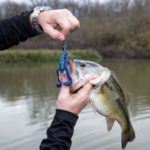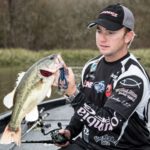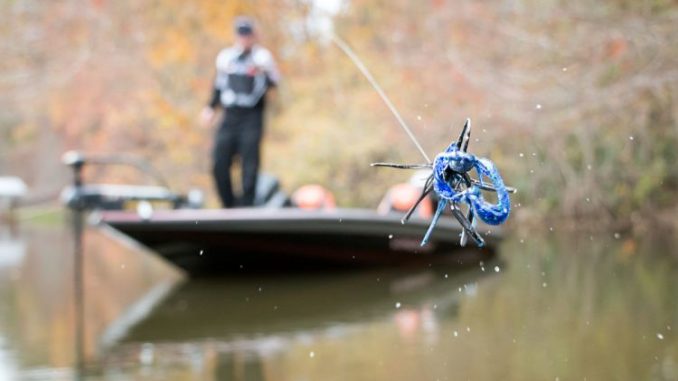
You have to finesse the bass to bite when winter is in it’s last throes, right? Not according to this Bassmaster pro, who said you can get bigger bites quicker by using heavy weights.
In 1989, the U.S. military surrounded General Manuel Noriega, who was holed up in the papal nuncio’s residence (the Vatican equivalent of an embassy) in Panama City.
While the Rangers probably would have rather gone full commando and blasted their way in to get him, cooler heads prevailed because any direct action against the embassy would have been an act of war against the Vatican.
Instead, a music barrier was erected around the embassy in an effort to force Noriega to surrender through psychological warfare.
Apparently the U.S. knew the soft stylings of smooth jazz would have little to no effect on Noreiga or the Catholic priests, who could potentially talk him into surrendering.
Instead of Frank Sinatra or Kenny G, they put on Judas Priest, Kiss, Twisted Sister, Van Halen, and Guns and Roses — and cranked the hopped up juke box to 10.
Simply put, the military needed to elicit a reaction, so they turned to heavy metal.
Noriega surrendered just days later.
Chad Wiley, a Bassmaster tournament pro from Pineville, was only 12 in 1989, but Operation Just Cause must have made an indelible mark on his life.
Sure, there have been times in his fishing career when Wiley could sweet talk a bass or two into biting with a subtle song and dance, but he learned a long time ago the best way to elicit a reaction out of a holed up in cover is to use heavy metal.
“Think about it like this,” Wiley said. “Let’s say I had a bologna sandwich, and you don’t like bologna sandwiches. If I tried to hand it to you gently, you’d wave your hand and shake your head politely to let me know you didn’t want it.
“But if I threw that same bologna sandwich at your face, you wouldn’t have any choice but to react and grab it out of the air.”
In Wiley’s mind, using heavy weights on jigs, Texas rigs and spinnerbaits is the same as throwing a bologna sandwich at somebody’s face: Bass don’t have time to politely refuse because the heavy weight banging around in the cover forces them to react.
Wiley and I were fishing Black River Lake near Monterey. He had patterned the bass in flooded shoreline vegetation the weekend before, and the subsequent 1-foot fall seemed only to improve the bite.
Although it wasn’t the thickest vegetation I had ever fished, Wiley was rigged us up with ¾-ounce tungesten weights ahead of thick wire hooks and bulky creature baits like the V&M Wild Thang Craw.
“Our goal is to make these fish bite,” he said as we idled away from the ramp at Horseshoe Lake Marina earlier that morning. “It’s cold, the water is falling — I imaging they’re going to be in a funk.
“Funky fish don’t want to bite, but we’re not going to leave that decision to them. We’re going make them bite.”
Why it works
When Wiley was a kid, a 3/16-ounce weight was just about all he threw. Back then, he considered a ¼-ounce weight to be heavy.
But the more bass he caught using 3/16-ounce weights the fewer post-tournament trips to the bank he got to make.
“I think smaller weights catch smaller fish because I’ve caught bigger fish the last 15 years of my tournament fishing,” Wiley said after sliding his first bass back into the water. “So I guess you could say bigger bass turned me on to using heavier weights.”
As he had mentioned earlier, these funky-feeling fish weren’t in any mood to hit something slow because they weren’t in the mood to eat.
“Bass are generally mean,” Wiley said. “Take that fish I just caught: It probably wouldn’t have hit a soft stick bait because he isn’t really looking to eat. But I threw that heavy weight by him and it fell so quickly that he didn’t have time to think about it.”
Another perfect example of Wiley’s heavy metal theory would be the old “think quick” trick with a basketball, when somebody acts like they’re going to throw the ball to an unsuspecting victim while hollering “think quick.”
The weekend before out trip, Wiley had marked several locations of flooded, shallow vegetation, and we spent the better part of the day making a milk run through those waypoints.
Because the water was falling, bass were set up on the deep side of the grass where they were likely targets for light baits, spinnerbaits and crankbaits, but Wiley was having none of that.
“Just because they’re more in the open water in front of the grass doesn’t mean we’re going to cut off our heavy weights,” he said. “The faster we can get our baits to fall the more bites I think we’re going to get.”
Wiley’s prediction was spot on, as our heavy baits knocked and banged around the cover like a possum stealing cat food on a front porch — at least the ones that come up on my front porch. If they were quieter I’d never even know they were there. As it is, though, the more noise they make the more likely I am to get up and go check it out.
And the bass were having none of the clamor Wiley and I were throwing in their faces.
I missed a bass and wondered aloud if fishing heavy weights requires any kind of hook-set adjustment.
No sooner had the words escaped my lips than Wiley set the hook into another fish.
“I guess to answer your question, if I would have been paying attention I would not have caught that fish,” he said. “He dropped it the first time he grabbed it, and I would have swung on him if I wasn’t paying attention to your question.
“Normally they eat it once, and you pop them and swing them in. But with the cloud cover and cold we’ve got today, it seems like they’re holding onto it a little better if you can feel them and draw down on them a little bit versus popping your line.”
Had we had a sunny sky, Wiley believed the bite would have been much more aggressive and the fish would have been much easier to hook.
“When you put this thing by his face about 90 mph, he’ll hammer it once he decides to bite,” Wiley said. “And he don’t have a lot of time to do that: When they have less time to make a decision, that usually leads to more-violent bites that turn into pretty easy hooksets.”
All about the gear
Because Wiley was getting way more bites than I was, I started closely investigating his gear. When two anglers are throwing generally the same thing, there is sometimes one tiny thing that makes it easier for one than the other.
I couldn’t find anything different with our baits, but I did notice that Wiley was fishing a rod that was way longer than my 7-footer. His reels were also spooled with braided line, whereas I was using mono.
“You’ve got to change your gear when you fish with heavy weights like these,” Wiley advised “Today I’m using a 7-foot, 8-inch six-power Denali Kovert rod. That extra length lets me whack them if they hit my bait and run with it.
“It’s also a light rod that’s easier on my wrists pitching these ¾- and 1-ounce baits all day.”
Wiley changes to a 7-6 rod if the water is 2 feet or less because the longer rod will actually sometimes get the fish up out of the water too quickly on the hook set, and they’re more likely to come off.
“Now if I’m skipping baits around and under flooded bushes, I go to a 7-foot rod to make it a little easier to maneuver around that stuff,” he explained.
And the braid is a given around heavy cover, especially grass. Wiley said he sticks with 65-pound P-Line because it helps with hooksets.
And, whereas mono tends to get balled up in the vegetation, braided line cuts through salad like a sawbriar and without any stretch. You want to get them up and out of that stuff quick, and braided line is about as direct a path as you can get between your hands and a bass.
While he was talking about gear, the angler said he always uses tungsten weights for heavy Texas-rigging.
“That’s a pretty simple explanation,” Wiley said. “Tungsten weights have a much smaller profile, which lead to better hook-ups. A 1-ounce tungsten weight is about the size of a 3/8-ounce lead weight. That’s a lot smaller chunk of weight that tends to slide out of the way rather than get in the way.”
To finish up his gear, Wiley spools his braid onto a Lew’s Super Duty reel made specifically for fishing braided line.
The take-home
Although we smashed them pretty good at Black River Lake, Wiley said one of the best days he has ever had fishing heavy weights was last spring at Toledo Bend.
The water was up 4 or 5 feet and in people’s yards. And he was catching them in some of the heaviest cover he had ever seen.
“Take that bush right there,” he said as we wrapped up our day. “That’s a Toledo Bend bush, kind of like what I was fishing. You can throw a 3/16- or ¼-ounce weight around it all day, and you’re not going to catch him — you’re going to have to get in there with him with some braid and a heavy weight.
“When you set the hook, sticks are going to fly.”
I asked Wiley if he thought we would have caught 13 bass during our trip had we been using lighter weights, and he surprised me with his answer.
“I think we might have,” Wiley said, “but we’d still be out there. It would have taken a long time, whereas with the heavy weights we were just going down through that grass — dunk, dunk, dunk. If he was there he hit it; that was obvious.
“It’s the basketball and bologna sandwich effect we talked about.”
Although the grass we fished looked rather innocuous at the surface, the bass were hanging out right in front of it, where there was more submerged grass that we could not see. The bass were either suspended right over that grass or just underneath it.
Kind of like Manuel Noriega, they were hoping to stay safe and unbothered within their refuge.
Too bad they didn’t know Wiley would be surrounding them with a virtual wall of heavy metal they could not ignore.
Their surrender was certain.
